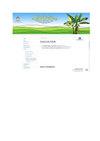特立尼达和多巴哥纳帕里马平原原甘蔗土地的土壤恢复力和管理
IF 0.3
Q4 AGRONOMY
引用次数: 0
摘要
特立尼达和多巴哥Naparima Peneplain的土地是一种宝贵的资源,具有多种土地利用特征,包括农业多样化。剖面被归类为V类土壤,不具弹性,中期恢复率最低;IV类土壤,具有轻微弹性,中期改善,导致土地管理和土地利用发生重大变化。从殖民时代到2003年糖厂关闭,这些土地已经种植了几个世纪的甘蔗。从那时起,与许多其他加勒比领土一样,这块土地一直被标记为农业多样化的标志,并被提供给小农户,用于生产国内市场的商品。后甘蔗时代的土地利用变化导致约14000公顷土地可用于农业多样化。然而,预期的对国内粮食供应的积极影响并没有实现。2012-2014年,对Caroni(1975)有限公司Naparima Peneplain土地上的La Gloria和Cedar Hill部分进行了土地资源研究,通过与历史记录中的数据进行比较,确定长期种植甘蔗(Saccharum officinarum L.)对土地退化和土壤复原力的影响,并就未来的发展方向提出建议。该研究包括对土地利用、土壤化学和物理性质以及土壤侵蚀程度的评估。最严重的土地管理因素是长期和广泛的土壤侵蚀,特别是在雪松山,还有底土暴露、土壤塌陷和移动等额外问题。土壤侵蚀研究(通用土壤流失方程(USLE))表明,估计35-74 t/ha影响75%的土地。土壤物理指标的历史记录,如堆积密度、剖面中的粘土百分比和可用水,表明这些参数在1977年至2014年期间是稳定的。然而,包括有机碳、氮和pH在内的化学指数反映了与土壤肥力下降和土地废弃相关的显著下降。虽然确定稳定的土壤恢复力指数是有价值的,但眼前的问题是纠正土壤侵蚀,这会导致相当大的土地废弃。因此,建议将土地恢复到可接受的土壤肥力水平,特别是有机质含量,并对基础设施进行调整,以阻止或大大减少土壤侵蚀,从而使这些土地能够用于促进国家粮食安全。本文章由计算机程序翻译,如有差异,请以英文原文为准。
Soil resilience and management of former sugarcane (Saccharum officinarum L.) lands on the Naparima Peneplain, Trinidad and Tobago
The lands of the Naparima Peneplain, Trinidad and Tobago, are an invaluable resource with multiple land use characteristics including agricultural diversification. Sections are classified as Class V soils, non-resilient with minimum recovery over the medium term, and as Class IV soils, slightly resilient with improvements in medium term resulting in significant land management and land use changes. These lands were under sugarcane cultivation for centuries, from the colonial era until the closure of the sugar factory in 2003. Since then, as in so many other Caribbean territories, the land has been ear-marked for agricultural diversification and made available to small farmers for the production of commodities for the domestic market. Land use changes in the post-sugarcane era have resulted in approximately 14,000 hectares becoming available for possible agricultural diversification. However, the positive impact on domestic food supply that was anticipated has not materialized.A land resource study was conducted in 2012–2014 in the La Gloria and Cedar Hill sections of Caroni (1975) Ltd lands on the Naparima Peneplain, to determine the effect of long-term sugarcane (Saccharum officinarum L.) cultivation on land degradation and soil resilience by comparison with data from historical records and to make recommendations on the way forward. Assessment of land use, chemical and physical soil properties, and extent of soil erosion, comprised the study.The most severe land management factor was identified as chronic and widespread soil erosion, especially in Cedar Hill, with additional problems of subsoil exposure, soil slumping and movement. Soil erosion studies (Universal Soil Loss Equation (USLE)) indicate estimates of 35–74 t/ha affecting 75% of the lands. Historical records on soil physical indices such as bulk density, clay percentage in the profile and available water, revealed that these parameters were stable over the period 1977–2014. However, chemical indices, inclusive of organic carbon, nitrogen and pH, reflect significant decline correlated with reduced soil fertility and land abandonment. While identifying stable soil resilience indices is valuable, the immediate problem is the correction of soil erosion, which results in considerable land abandonment. Therefore, it is recommended that the land be restored to an acceptable level of soil fertility, specifically with respect to its organic matter content, and that infrastructural adjustments be made to stop or greatly minimize soil erosion so that these lands could be used to contribute to national food security as envisaged.
求助全文
通过发布文献求助,成功后即可免费获取论文全文。
去求助
来源期刊

Tropical Agriculture
Social Sciences-Development
CiteScore
0.50
自引率
0.00%
发文量
0
期刊介绍:
The overarching aim of Tropical Agriculture is to contribute to the process of agricultural development in tropical agro-ecosystems, through publication of papers in the area of agricultural science and technology. The specific objectives of the Journal are: -To address the practical aspects of sustainable tropical agriculture production, improvement, protection and commodity utilization, worldwide. -To foster the application of science and technology to understanding and removal of constraints to tropical agricultural productivity. -To publish the results of original research which make significant contributions to knowledge on the practice of sustainable and productive tropical agriculture. The Journal publishes papers in the following areas of tropical agriculture: -Soil Science and Technology -Environmental Science and Technology -Crop Science and Technology -Livestock Science and Technology as well as: Food and Nutrition Policy, Post-Harvest Technology, Agricultural Economics and Extension, Agribusiness
 求助内容:
求助内容: 应助结果提醒方式:
应助结果提醒方式:


